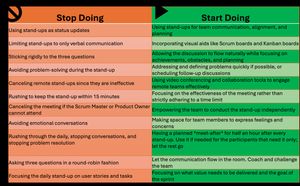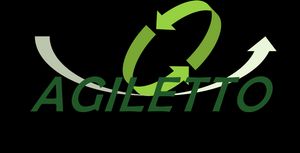9 Daily Stand-Up Myths Busted: Transform Your Agile Meetings
The daily stand-up, also known as the daily huddle or Scrum meeting, is a cornerstone of agile practices. Despite its simplicity, this brief daily meeting is often misunderstood which can undermine its effectiveness. In this article, I will debunk ten common myths about the daily stand-up to help teams optimize this crucial activity. Read to the end for tips on conducting successful stand-ups. So, let's do it!

Myth #1: The Stand-Up Must Happen Every Morning
Myth: The daily stand-up must occur every morning to be effective.
Effects: By living this myth, teams force a rigid schedule that might not suit everyone, especially in remote or distributed setups, leading to decreased attendance and engagement.
Reality: While having a morning stand-up helps plan the day, the timing can be flexible. The key is that the team finds a rhythm that suits them best. The keyword here is team—it is up to the team to decide, not the Scrum Master nor the Product Owner. The team decides whether the meeting is held in the morning, midday, or at the end of the day. The goal is alignment and planning; teams should choose the time that works best for them and when everyone can attend. Since many teams are remote and in different time zones, some might attend in the morning while others attend the same meeting in the afternoon.
Regarding frequency, it is also up to the team. However, keep in mind that the meeting is called "daily" for a reason. It should be a fast learning loop for the team. If the team prefers less frequent meetings, it is probably a symptom of something else. Why does the team not find the daily stand-ups valuable? Is it just a must for them? What do we need to change to make them an essential part of every workday? These are just some of the questions the Scrum Master can coach the team with.
Myth #2: The Meeting Must Strictly Adhere to the Three Questions
Myth: The stand-up must strictly follow the three questions: What did I do yesterday? What will I do today? Do I have any obstacles?
Effects: By adhering rigidly to these questions, meetings become mechanical and uninspiring, stifling natural discussion and team engagement.
Reality: These three questions are guidelines to help structure the discussion, not a rigid script. The essence of the stand-up is to enable communication about the next steps towards the sprint goal – celebrating achievements, identifying obstacles, and planning the coming day. Teams can adapt the format to suit their needs. It's up to the team to let the discussion flow, with the Scrum Master guiding and coaching the team during the short daily stand-up meetings.
I often say that I can judge a team based on their daily stand-up, and it is very true. If the meeting is mechanical, following a script with no discussions, it is very common that the team is also mechanical and does not discuss or work effectively as a team.
Myth #3: The Stand-Up Is a Status Meeting in Disguise
Myth: The daily stand-up is a status meeting in disguise for the Scrum Master and Product Owner to understand where the team is. This leads to stand-ups becoming status updates where team members report achievements, plans, and obstacles directly to the Scrum Master and sometimes the Product Owner. The meeting is not very fruitful, and discussions are often more or less forbidden.
Effects: By treating stand-ups as status meetings, the collaborative spirit of the team is undermined, turning the meeting into a reporting session rather than a cooperative planning session, in total opposition to the desired agile mindset. Team members avoid the meetings or try to convince the Scrum Master they are not needed.
Reality: The daily stand-up is meant to be a team sync meeting. It is a collaborative, creative, crucial, and fun meeting for the team to sync up, celebrate success, plan their work for the day, and identify any blockers. The primary audience is the team members, and the focus is to foster teamwork. How do the team cooperate best towards the common goal? Cooperation means working together, thinking together, solving problems together, and learning together.
Myth #4: No Problems Should Be Solved During the Stand-Up
Myth: Any problems or impediments raised during the stand-up must not be resolved within the meeting. The meeting is for updates, not for resolving problems.
Effects: By living this myth, teamwork is impeded, and team members are forbidden to discuss problems, reverting to simple statements about problems and achievements. Simple solutions to significant problems are delayed, and the daily meetings risk becoming status updates in disguise, as described in Myth #3.
Reality: While the primary objective of the stand-up is to identify problems rather than solve them, it is still a good place to define the problem and decide how the team should continue to work on it. Issues that jeopardize the team's plan need to be addressed promptly. If they are important enough and can be solved with a five-minute discussion, why not? If the issue cannot be resolved immediately, it should be noted and addressed after the stand-up in a separate meeting to keep the daily stand-up short.
Myth #5: The Meeting Must Be Max 15 Minutes Long
Myth: The daily stand-up must be a maximum of 15 minutes long and should not exceed this duration. The Scrum Master's primary mission is to keep the team members brief to adhere to the time limit.
Effects: The Scrum Master's most important job during the daily will be to keep the 15 minutes limit, not to coach the team into a new plan for the day, supporting problem resolution and celebrating success.
Reality: While the stand-up is meant to be brief, its length can vary. If discussions occasionally extend beyond 15 minutes, it might be due to significant issues that need addressing. Conversely, if the meeting is consistently shorter, it could indicate that key issues are not being discussed thoroughly. The focus should be on the effectiveness of the meeting rather than strictly adhering to a time limit. A tip is to institute a meet-after, block half an hour extra for all participants, and if needed use that half-an-hour for productive problem resolution with the involved team members only, letting the non-involved get back to work.
Myth #6: The Scrum Master and Product Owner Must Attend
Myth: The Scrum Master and Product Owner must attend every stand-up for it to be effective.
Effects: Meetings are canceled if the Scrum Master and/or Product Owner cannot attend, reducing the team's workflow and continuity.
Reality: The daily stand-up is primarily for the team to coordinate their efforts. While the Scrum Master and Product Owner play significant roles, their presence is not mandatory for the meeting to be effective. Their attendance can be beneficial, especially for addressing escalated issues, but the team should be empowered to conduct the stand-up independently. This helps avoid turning the meeting into a status report and keeps the focus on team collaboration.
Myth #7: Only Verbal Communication Is Allowed
Myth: During the stand-up, only verbal communication should be used, and visual aids or tools are unnecessary and will just hinder the team discussion. Showing code is an absolute no-no.
Effects: Team members are stopped from getting the complete picture.
Reality: Visual aids such as Scrum boards, Kanban boards, and burn-up charts can be incredibly helpful during the stand-up. They provide a quick visual reference for the team's progress, making it easier to identify issues and update the team on the status of tasks. Showing code or a fault on an application can increase understanding. This myth likely arises from experiences where teams focus too much on updating the board, turning the meeting into a board management session rather than a productive discussion.
Using visual aids can enhance clarity and understanding during the meeting. If the board needs updating due to information revealed during the stand-up, it should be updated afterward. It is important to note that updating the board is a team responsibility, not solely the Scrum Master's task.
Myth #8: Stand-Ups Are Ineffective for Remote Teams
Myth: Daily stand-ups don't work well for remote or distributed teams and are only effective when conducted in person.
Effects: Teams might resort to status update emails or using tools like Slack or Teams to just answer the three questions (see Myth #2 and #3), in order to "keep on working."
Reality: Daily stand-ups can be highly effective for remote teams when conducted properly. In fact, they are especially important since remote teams miss out on spontaneous corridor meetings. While there are challenges for remote teams, the use of video conferencing tools and online collaboration platforms like Miro and Mural can make remote stand-ups almost as productive as in-person ones. The key is to ensure everyone is engaged and uses cameras so team members can read each other's facial expressions. A good coach or Scrum Master can facilitate the meeting effectively for the team.
Myth #9: We Should Tick Off User Stories and Tasks During the Daily Stand-Up
Myth: During the daily stand-up meeting, we should tick off all tasks that we have done, and user stories that the team has completed.
Effects: The meeting becomes a board-update meeting.
Reality: We should focus on the purpose of the meeting: to celebrate success, plan the coming day, and resolve issues and impediments. The board updates can be done either before or after the meeting by the team.
Facilitator Tips for a Successful Daily Stand-Up
To ensure your daily stand-up meetings are effective and valuable, consider the following tips:

And last tip: create a purpose for this meeting, as with every meeting. Put it up on a wall in the meeting room or similar. Why not do it as an exercise with the team? What would happen if you did?
Summary
The daily stand-up is a tool for team alignment and planning, and its success lies in its flexibility and focus on communication rather than rigid adherence to specific rules. By debunking these myths and following best practices, teams can better utilize the daily stand-up to foster collaboration, transparency, and continuous improvement.
In a coming article, I will answer the quite common question: "What do I do as a Scrum Master when the team says they don't need daily stand-ups?"
Last updated May 27, 2025
